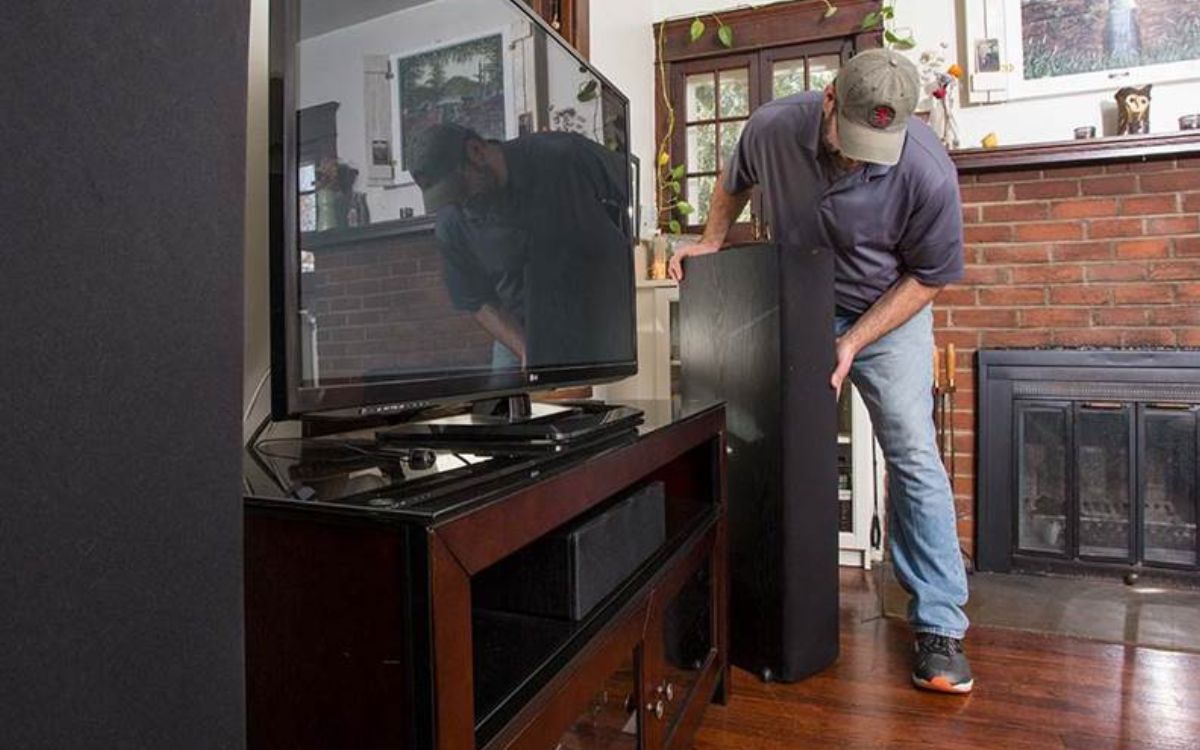Home>Production & Technology>Surround Sound>Why Does It Seem Like The Surround Sound Is Louder Then The People Talking


Surround Sound
Why Does It Seem Like The Surround Sound Is Louder Then The People Talking
Modified: January 22, 2024
Learn why surround sound can seem louder compared to people talking and discover possible reasons for this phenomenon.
(Many of the links in this article redirect to a specific reviewed product. Your purchase of these products through affiliate links helps to generate commission for AudioLover.com, at no extra cost. Learn more)
Table of Contents
- Introduction
- Understanding Surround Sound
- Perception of Sound
- Factors Affecting Sound Perception
- The Role of Speaker Placement
- The Impact of Surround Sound Technology
- Human Hearing and Sound Localization
- Psychological Factors in Sound Perception
- Volume Imbalance in Surround Sound Systems
- Adjusting Sound Levels for Balance
- Conclusion
Introduction
Surround sound systems have revolutionized the way we experience audio, providing an immersive and captivating environment for movies, music, and gaming. However, many people have noticed that the surround sound seems to be louder than the people talking, raising questions about the reasons behind this phenomenon. This article aims to shed light on the factors that contribute to this perception and explore why it may seem like the sound is louder than the dialogues.
Surround sound technology involves the use of multiple audio channels and speakers strategically placed around a room to create a three-dimensional auditory experience. This setup enables sound effects to be localized and move seamlessly across the space, enhancing the overall immersion. However, this immersive experience may lead to a perceived imbalance in sound levels, where the surround sound appears louder compared to the dialogue.
To understand this phenomenon, it is essential to delve into the intricacies of sound perception and the various factors that influence how we perceive sounds. Our perception of sound is a complex process involving our ears, brain, and psychological factors.
Factors such as speaker placement, the quality of the audio equipment, and the content being played also play a crucial role in the perception of sound levels. By exploring these factors and understanding how they contribute to the perception of surround sound being louder than dialogue, we can better optimize our audio setups and create a more balanced listening experience.
Understanding Surround Sound
Surround sound is a technology that is designed to create a lifelike and immersive audio experience. It involves placing speakers strategically around a room to reproduce audio from multiple channels. The goal is to envelop the listener in sound, making them feel like they are part of the action.
Typically, a surround sound system consists of at least five speakers: a center speaker for dialogue, front left and right speakers for music and sound effects, and rear left and right speakers for surround sound effects. Some advanced systems may include additional speakers for enhanced precision and depth.
The audio content is encoded and divided into different channels, allowing specific sounds to be played through different speakers. For example, dialogue is usually directed to the center speaker, while ambient sounds and effects are distributed across the front and rear speakers.
The distribution of sound across multiple channels creates a sense of depth, realism, and immersion. When properly set up and calibrated, the surround sound system can transport the listener into the world of the movie, concert, or game.
One of the most widely used surround sound formats is Dolby Digital, which uses a 5.1 channel setup. The “5” refers to the five main speakers (center, front left, front right, rear left, and rear right), while the “.1” refers to the dedicated subwoofer channel for low-frequency effects (bass). This format provides a balanced and realistic audio experience.
It’s important to note that the quality of the speakers and the audio content being played also greatly influence the overall experience. High-quality speakers can reproduce sounds accurately and with precision, while poorly calibrated or low-quality speakers can result in distortion or inconsistencies in sound reproduction.
Now that we have a basic understanding of surround sound systems, let’s dive into the factors that impact our perception of sound levels and explore why the surround sound might appear louder than the dialogue.
Perception of Sound
Our perception of sound is a complex process that involves the interaction of our ears, brain, and psychological factors. It goes beyond the physical characteristics of sound waves and includes subjective elements that can vary from person to person.
When sound waves enter our ears, they vibrate the eardrums, which then transmit these vibrations to the inner ear. In the inner ear, the vibrations are transformed into electrical signals that are sent to the brain through the auditory nerve. The brain processes these signals and interprets them as sound.
However, sound perception is not solely determined by the physical properties of the sound waves. Factors such as our past experiences, cultural background, attention, and cognitive processes play a significant role in how we interpret and perceive sounds.
One important aspect of sound perception is the ability to locate the source of sounds in space. Our brain analyzes subtle differences in the timing and intensity of sound waves reaching each ear to determine the direction and distance of the sound source. This sound localization ability is crucial in creating an immersive surround sound experience.
Furthermore, our psychological state, emotions, and expectations can also influence our perception of sound. For example, if we are watching an action-packed movie, our anticipation and excitement may make us more receptive to the surround sound effects, making them appear louder in comparison to the dialogue.
Additionally, our attention plays a crucial role in sound perception. When we are fully engaged with the visuals and storyline of a movie or game, we might become less aware of the dialogue and more attuned to the surround sound effects, resulting in the perception of louder surround sound.
Understanding these aspects of sound perception helps us grasp why the surround sound might seem louder than the dialogue in certain situations. By considering the interplay between our physical hearing capabilities, cognitive processes, and situational factors, we can better optimize our surround sound setups to achieve a more balanced and enjoyable audio experience.
Factors Affecting Sound Perception
Several factors can influence our perception of sound, including the volume, frequency, timing, and spatial characteristics of the sound waves. Let’s explore some of the key factors that contribute to how we perceive sound levels and why the surround sound may appear louder than the dialogue.
Volume: The volume or intensity of a sound wave is directly related to its perceived loudness. When we hear sounds in a surround sound system, the volume levels of different channels can vary. If the surround sound effects are mixed at a higher volume compared to the dialogue, it can create the perception that the surround sound is louder than the people talking.
Dynamic Range: The dynamic range refers to the difference between the softest and loudest sounds in a piece of audio or a sound system. Surround sound systems are designed to reproduce a wide dynamic range, capturing both quiet whispers and explosive action scenes. However, if the dynamic range is not properly balanced, it can result in certain elements, such as surround sound effects, appearing disproportionately louder than the dialogue.
Frequency Response: The frequency response of a sound system refers to its ability to reproduce different frequencies accurately. If the speakers in a surround sound system are biased towards reproducing certain frequencies more prominently, it can give the perception that the surround sound effects are louder compared to the dialogue, which may occupy a different frequency range.
Speaker Placement: The placement of speakers in a surround sound system is crucial for achieving an accurate and balanced sound field. If the rear surround speakers or the subwoofer are placed too close to the listener or if the center speaker is not properly aligned, it can create an imbalance in sound levels. Improper speaker placement can contribute to the perception that the surround sound is louder than the people talking.
Audio Mixing: The way audio content is mixed and mastered can impact our perception of sound levels. Sound engineers carefully mix different audio elements to create a balanced audio experience. However, if the dialogue is mixed at a lower level compared to other elements, such as music or sound effects, it can give the impression that the surround sound is louder than the dialogue.
Pyschological Factors: Our psychological state, attention, and expectations can also influence how we perceive sound levels. If we are more focused on the surround sound effects and less attentive to the dialogue, the surround sound may appear louder in comparison. Similarly, our expectations and previous experiences can shape our perception of audio balance.
By considering these factors and implementing optimizations in speaker placement, audio mixing, and system calibration, it is possible to achieve a more balanced sound experience in a surround sound system.
The Role of Speaker Placement
The placement of speakers in a surround sound system is crucial for achieving an accurate and balanced sound field. Proper speaker placement ensures that the sound from each channel reaches the listener at the right timing and intensity, creating a cohesive and immersive audio experience.
When positioning the speakers, it is important to consider factors such as room shape, size, and acoustics. Here are some key aspects of speaker placement that can impact the perception of sound levels in a surround sound system:
Center Speaker: The center speaker is responsible for reproducing dialogue and other center-channel audio. It should ideally be placed directly in front of the listener, either above or below the display screen. This helps to ensure that the dialogue is projected accurately and centered in the soundstage, minimizing any imbalance in sound levels.
Front Speakers: The front left and right speakers handle most of the music, sound effects, and ambient sounds. They should be positioned at an equal distance from the center speaker and angled inwards to create a cohesive soundstage. This uniformity in placement helps to maintain a balanced sound mix between the dialogue and surround sound effects.
Surround Speakers: The rear surround speakers are responsible for reproducing the surround sound effects and creating a sense of immersion. They should be placed to the sides or slightly behind the listening area, at an angle that directs sound towards the listener. Properly positioned surround speakers help to enhance the surround sound experience without overpowering the dialogue.
Subwoofer: The subwoofer is dedicated to reproducing low-frequency sounds and adding depth to the overall audio experience. Its placement is less critical since low-frequency sounds are non-directional. However, placing the subwoofer near a wall or in a corner of the room can help to amplify the bass effect. Care should be taken to avoid excessive bass that can overpower the dialogue and other elements.
Additionally, room acoustics can affect speaker placement and sound perception. The size, shape, and materials in the room can impact sound reflections and create acoustic issues such as echoes or excessive reverberation. Acoustic treatments such as wall panels, bass traps, and diffusers can be used to minimize these issues and optimize the sound balance.
By carefully considering speaker placement and optimizing for room acoustics, it is possible to create a balanced and immersive surround sound experience. Properly positioned speakers enable the dialogue and surround sound effects to blend seamlessly, reducing the perception that the surround sound is louder than the people talking.
The Impact of Surround Sound Technology
Surround sound technology has had a significant impact on the way we experience audio in various forms of entertainment, including movies, music, gaming, and virtual reality. The implementation of surround sound systems has transformed the way sound is reproduced, enhancing immersion and creating a more realistic and engaging audio environment.
Here are some key ways in which surround sound technology has impacted our audio experiences:
Immersive Audio Experience: Surround sound systems are designed to envelop the listener in sound, creating a three-dimensional audio experience. By utilizing multiple speakers and channels, surround sound technology allows sounds to come from different directions, enhancing the sense of being in the midst of the action. This immersive audio experience adds depth, realism, and excitement to movies, concerts, and games.
Precise Sound Localization: One of the main advantages of surround sound technology is its ability to accurately localize sound sources. By distributing sound across multiple channels, surround sound systems allow for precise placement of sound effects, music, and dialogue. This creates a more realistic and immersive listening experience, where the sound appears to come from specific directions or move fluidly through the space.
Enhanced Spatial Audio: Surround sound systems take advantage of the inherent spatial capabilities of human hearing. Human ears can perceive subtle differences in the timing and intensity of sound waves reaching each ear, allowing us to determine the direction and distance of a sound source. Surround sound technology leverages this ability to create a more realistic and spatially accurate audio experience.
Sound Effects and Ambience: Surround sound technology enables the reproduction of detailed sound effects and ambient sounds. This is particularly valuable in movies and gaming, where surround sound systems can create a rich audio environment with sounds that move seamlessly around the listener. From the rustling of leaves to the roar of an approaching vehicle, surround sound amplifies the impact of sound effects, enhancing the overall immersion.
Increased Dynamic Range: Surround sound systems have the capability to reproduce a wide dynamic range, capturing both soft whispers and powerful explosions. This expanded dynamic range allows for a more nuanced audio experience, where quiet moments have as much impact as the loudest action sequences. It adds depth and realism to the audio content, making it more engaging and emotionally captivating.
Overall, surround sound technology has revolutionized the way we perceive and experience audio. It has elevated the quality of audio in entertainment, transporting us into the heart of the action and heightening our emotional connection to the content. By harnessing the power of surround sound, we can enjoy a more immersive and captivating audio experience across various forms of entertainment.
Human Hearing and Sound Localization
Our ability to hear sound and accurately locate its source is a remarkable talent of the human auditory system. Through a combination of physical and cognitive processes, we are able to perceive sound in three dimensions and determine the direction and distance of its origin. This ability, known as sound localization, plays a crucial role in creating a realistic and immersive audio experience, especially in surround sound systems.
Sound localization is enabled by several factors related to our ears and brain:
Binaural Hearing: We have two ears, each positioned on opposite sides of our head. As sound waves reach our ears, they travel different paths and arrive at slightly different times. The brain processes these temporal differences to determine the direction of the sound source. This process, called binaural hearing, allows us to perceive whether a sound is coming from the left, right, front, or back.
Head-Related Transfer Function (HRTF): The shape of our ears, head, and torso influences how we perceive sound. This unique anatomy creates subtle filtering and changes in sound as it reaches our ears. These individual differences, known as HRTF, provide important cues that our brain uses to localize sounds accurately and determine their elevations.
Interaural Level and Time Differences: The varying intensity and timing of sound reaching our two ears also contribute to sound localization. Sounds originating from one side of the body will usually reach the ear closer to the sound source with a higher intensity and shorter time delay compared to the other ear. Our brain processes these level and time differences to determine the location of the sound.
These mechanisms work together to enable us to pinpoint the direction of sound sources in our environment. Surround sound technology takes advantage of these natural processes to create a realistic and immersive audio experience.
In a surround sound system, audio engineers use techniques like panning and spatial filtering to create the illusion of sound coming from different directions. By distributing sound across multiple speakers, each channel representing a specific direction, the system can replicate the intricacies of real-world sound localization.
For example, if a dialogue is meant to come from the center of the screen, it will often be reproduced through the center speaker, aligning with our natural perception of where sound from a person speaking would originate. On the other hand, surround sound effects, such as footsteps or a passing car, can be distributed across the rear speakers, creating the perception of sound coming from behind us.
Understanding the complexities of human hearing and sound localization helps audio engineers and sound designers create surround sound systems that amplify the immersive experience. By replicating the natural cues our auditory system relies on, surround sound technology enhances the sensation of being present in the audio environment, elevating our enjoyment of movies, music, and games.
Psychological Factors in Sound Perception
Sound perception is not solely determined by the physical characteristics of sound waves; our psychological and cognitive processes also play a significant role in how we interpret and perceive sounds. These psychological factors can impact our perception of sound levels and contribute to why surround sound may seem louder compared to dialogue. Let’s explore some of these factors:
Attention: Our attention plays a crucial role in sound perception. When we are fully engrossed in a movie, concert, or game, our attention may be more focused on the visuals and the overall storyline rather than the dialogue. As a result, we may be less aware of the volume of the dialogue and more attuned to the immersive surround sound effects. This can create the perception that the surround sound is louder than the people talking.
Expectations: Our expectations can influence how we perceive sound levels in a surround sound system. For example, when watching an action-packed movie, we might anticipate intense surround sound effects and exciting music. Our heightened expectations and excitement can make us more receptive to these elements, causing them to appear louder in comparison to the dialogue.
Emotional State: Our emotional state can also impact sound perception. Certain sounds, such as loud explosions or intense music, can evoke strong emotions and physiological reactions. When experiencing heightened emotions, our perception of sound can be altered, and the surround sound effects may seem more prominent and louder compared to the dialogue.
Past Experience: Our past experiences shape our sound perception. If we have been exposed to surround sound systems that are imbalanced in terms of sound levels, we might develop a subjective expectation that surround sound should be louder. This past experience can influence our perception and contribute to the notion that surround sound is louder than the dialogue.
Mental Imagery: Our ability to create mental imagery based on auditory cues can also affect our perception of sound levels. Surround sound systems are designed to create a sense of space and realism by distributing sound across multiple speakers. This spatial audio design can lead us to mentally imagine the sound coming from different directions, emphasizing the impression that the surround sound is louder than the dialogue.
It is important to recognize that these psychological factors can vary from person to person, and individual preferences and prior experiences can greatly influence sound perception. By understanding these psychological factors, audio engineers can optimize sound mixing and calibration to achieve a balanced audio experience that accounts for the listener’s psychological and cognitive processes.
Ultimately, it is the delicate interplay between the physical properties of sound, the capabilities of our auditory system, and our psychological processes that contribute to our perception of sound levels and the apparent loudness of surround sound compared to dialogue.
Volume Imbalance in Surround Sound Systems
One common issue that can contribute to the perception of surround sound being louder than dialogue is volume imbalance within a surround sound system. The different audio channels in a surround sound setup, such as dialogue, music, and sound effects, may have varying volume levels due to the way they are mixed or encoded.
The dialogue channel is typically positioned in the center speaker to ensure clear and intelligible speech. However, in certain cases, dialogue may be mixed or encoded at a lower volume level compared to other audio elements, such as music or sound effects. This can result in the surround sound effects appearing disproportionately louder, creating an imbalance in sound levels.
Volume imbalances can stem from a variety of sources, including the audio mixing process and the content itself. Sound engineers use their expertise to create a mix that balances the various audio elements, but sometimes inconsistencies can occur. Additionally, variations in the audio content itself, such as different soundtracks or audio formats, can contribute to volume imbalances between the dialogue and surround sound effects.
The perception of louder surround sound compared to dialogue can also be influenced by our attention and expectations. As viewers, we may naturally gravitate towards the immersive surround sound effects, which are often designed to be more dynamic and attention-grabbing. This can make the dialogue appear relatively quieter in comparison, even if there is not necessarily a volume imbalance.
To address volume imbalances in a surround sound system, there are a few steps that can be taken:
Audio Calibration: Ensuring that the audio system is properly calibrated can help balance the sound levels. This can be achieved through speaker level adjustments, volume calibration, or using automatic audio calibration systems provided by the audio equipment manufacturers.
Audio Settings: Many audio systems offer options for adjusting the balance and volume levels of individual audio channels. Experimenting with these settings can help achieve a more balanced sound mix where the dialogue is clear and the surround sound effects are appropriately integrated.
Content Configuration: Some movies, TV shows, or gaming content may offer audio settings that allow customization of the dialogue and surround sound levels. Checking for these settings and making adjustments can help achieve a more balanced audio experience.
Professional Assistance: In cases where volume imbalances persist, seeking professional assistance from audio technicians or sound engineers can be beneficial. They can help identify and address any technical issues or provide guidance on optimizing the audio system and content for a balanced sound mix.
By addressing volume imbalances and ensuring a balanced sound mix, the perception of the surround sound being louder than dialogue can be minimized. This allows for a more immersive and enjoyable audio experience, where all audio elements are harmoniously blended together.
Adjusting Sound Levels for Balance
To achieve a balanced and harmonious audio experience in a surround sound system, it is important to adjust sound levels properly. This ensures that dialogue, music, and sound effects are heard at appropriate volumes, minimizing the perception of the surround sound being louder than dialogue. Here are some steps you can take to adjust sound levels for optimal balance:
1. Speaker Levels: Begin by checking the individual volume levels for each speaker in your surround sound system. Most audio receivers provide speaker level adjustments that allow you to increase or decrease the volume for each channel. Ensure that the dialogue channel, typically played through the center speaker, is set at a comfortable and audible level.
2. Audio Calibration: Utilize the audio calibration feature offered by many audio receivers or sound systems. This automated process measures the distance between the speakers and your listening position and adjusts the sound levels and delays to optimize the listening experience. This calibration helps to ensure that sound is evenly distributed and properly balanced throughout the room.
3. Dialogue Enhancement: Some audio systems offer settings specifically designed to enhance dialogue clarity. Activate this feature, if available, to ensure that dialogues are accentuated and intelligible. It can help boost the volume and enhance the frequency range of the dialogue channel, making it more prominent in the mix.
4. Sound Mode Selection: Many audio systems have different sound modes or presets that cater to various content types, such as movies, music, or gaming. Experiment with different sound modes to find the one that provides the most balanced sound mix for your specific preferences and the content you’re enjoying.
5. Manual Adjustment: If you still perceive a volume imbalance between the surround sound effects and dialogue, manual adjustments can be made. Some audio systems allow you to manually adjust the individual channel levels to achieve a more desired balance. Increase or decrease the surround sound channel levels until you find a balance that suits your listening preferences.
6. Content-specific Adjustments: Some movies, TV shows, or gaming content might offer specific sound settings or mix options. Check the audio settings within the content itself to see if there are any options to adjust the relative levels of dialogue and surround sound effects. Make adjustments based on your preference and the content’s recommendations for the best listening experience.
Remember, achieving the perfect balance will depend on your personal preferences and the specific audio equipment you are using. Experimentation and fine-tuning are key to finding the ideal blend of sound levels for a satisfying audio experience.
By carefully adjusting the sound levels and ensuring a balanced mix, you can create an immersive soundscape where dialogue, music, and surround sound effects complement each other, resulting in a more enjoyable and lifelike audio experience.
Conclusion
Surround sound systems have revolutionized our audio experiences, providing immersive and captivating soundscapes for movies, music, and gaming. However, the perception that the surround sound is louder than dialogue can be a common phenomenon. Understanding the factors that contribute to this perception is essential for optimizing our audio setups and achieving a balanced sound mix.
Throughout this article, we have explored various aspects that impact sound perception and contribute to the perception of imbalanced sound levels. We have discussed how surround sound technology creates an immersive audio experience, the role of speaker placement in achieving a cohesive sound field, and the impact of psychological factors on our perception of sound.
We also addressed specific issues such as volume imbalances and provided practical solutions, including adjusting speaker levels, utilizing audio calibration, and optimizing content-specific settings. By taking these steps, we can achieve a better balance between dialogue and surround sound effects, creating a more enjoyable and well-rounded audio experience.
It is important to remember that sound perception is a subjective experience, influenced by factors such as attention, expectations, and past experiences. What works well for one person may differ for another. Therefore, it is essential to fine-tune and customize sound settings based on individual preferences and specific audio equipment.
The ultimate goal is to strike a balance in the sound mix, where dialogue is clear and intelligible while surround sound effects enhance the immersion without overpowering the conversation. Achieving this balance creates an audio experience that draws us deeper into the content, allowing us to fully appreciate the richness and depth of the audio.
By understanding the complexities of sound perception, utilizing proper speaker placement, addressing volume imbalances, and adjusting sound levels for balance, we can optimize our surround sound systems for a more satisfying and immersive audio experience.
As technology continues to evolve, advancements in surround sound systems will likely provide even more precise and realistic audio environments. By staying informed and adapting our setups accordingly, we can continue to elevate our audio experiences and unlock the full potential of surround sound technology.











